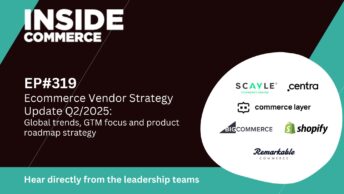In this episode we sit down with Attraqt Chief Strategy and Innovation Officer, Nicolas Mathon, and VP Go-To-Market, Imran Chaudhary to explore the cultural shift to AI-driven personalisation and operational challenges doing product discovery at scale.
Get a product discovery buyer’s guide
Attraqt has just published a helpful Ecommerce Product Discovery Engine Buyer’s Guide, authored by James. You can request the guide here.
Listen on your favourite player
Watch the video
Tl;dr
- Key trends in ecommerce product discovery
- The cultural shift to AI-driven personalisation
- Complexities of product discovery at scale and for global brands
Ecommerce has evolved to stop talking about search, browse, recommendations and personalisation separately and now the focus is on product discovery, which cuts across all these disciplines. As search, merchandising and recommendations merge to deliver personalisation across the user experience, product discovery engines play a key role in driving product engagement and conversion.
Attraqt is the convergence of Fredhopper and Locayta. They have an impressive customer base including ASOS, Fanatics, Selfridges and Screwfix so have a wealth of knowledge from real world projects.
Discussion notes
- Let’s warm everyone’s brains up with a summary of the latest product discovery trends for ecommerce: how’s the economic concern impacting ecommerce business mindsets, what are people focused on and how is this impacting investment and demand?
Imran:
We launched two reports recently, obviously the typical Peak Trading Report that’s kind of a given, and a commissioned report with London Business Research on ‘The State of Product Discovery’
Peak trading we saw a slight dip of about 1.5% in requests during that peak week, but whats interesting is Black Friday accounted for only 11% of the total of that week – The lowest we have seen in five years. When we look at all requests Jan to Nov, the 11 days accounted for about 3.3% of all requests for that time period vs 4.8% in 2021 so for sure the period is being hit by the cost of living but also we see the period starting to lose its relevance for shoppers.
Obviously the cost of living crisis is squeezing disposable income and merchants are drilling down on the tools to help rebalance the impact. The State of Product Discovery report highlighted to us that 62% of merchants will be focusing on product discovery as a core strategy to improve conversion and ROI this year and just under 60% of merchants surveyed and looking to AI to help improve their efficiencies and in turn their margins.
- AI gets a lot of press now but it’s a key shift from manual and rule-based approaches: what are the operational implications for an ecom team wanting to implement an AI engine, what impact does it have on ways of working?
Nicolas:
The first big implication is the change in term of mindset. Trying to apply AI to a fully rule-based configuration is challenging because it does not give enough room for the AI to learn. It’s better to start by removing as many rules as possible, activate AI, and then apply rules where we want to add more curation and to drive a little more what is presented to the shopper. It could sound complicated, but it’s also a big opportunity to do a big cleaning and, as a merchandiser, you will win a lot of time afterward. The big issue with rule-based systems is that you end up with thousands of rules and sharing the knowledge internally is a huge challenge. AI is a good opportunity to rationalise what rules are key for the business, and what can be automated. It allows you to maximize ROI, but also to free up some merchandiser time for things which are business critical.
- Can you provide some search specific context: what AI features does Attraqt provide for on-site search, what are the benefits for merchants and what measurable improvements can you share?
Imran:
From a search perspective merchants have been uncovering revenue by focusing on the long tail of search, so this is the low volume unique search queries that often have no optimisation against them therefore resulting in either zero or irrelevant results. It accounts on average to about 20% of all search queries but given every search query typically has a commercial value of just under £4 on average this is a key area to look at improvement. The challenge is the time and effort doesn’t pay off using manual search rule techniques, people just don’t have the time to address all the unique queries at low volume. This is low hanging fruit for AI to analyse and optimise on their behalf and see quick return in value. Typically we see we can remove 97% of the long tail by leveraging AI and therefore uncovering new revenue opportunities with little manual intervention.
- And how does it affect skill sets – what new skills does a business need to get the most from an AI and ML solution?
Nicolas:
The AI market is getting more mature and solutions like Attraqt allows you to apply AI and ML solutions without any skill, other than merchandising and business skills of course.
That being said, we see two types of companies: the one who think AI is critical for their business, and they want to massively invest in it, and the one who think it’s a must-have but it’s an add-on to their business strategy. The first type will usually create an AI team with data scientists and data engineers and they will develop their own algorithms, gathering data from all the departments of the organization and spreading AI in all the systems and channels. The second type will mainly rely on best-in-class partners to help them leveraging AI on their critical channels.
At Attraqt, we can work with both. Because we built an algorithm orchestrator, we can host and activate algorithms created by our clients. We allow them to add a level of human control on top of it (which is required by merchandisers and very often forgotten by data science teams). We also have a library of algorithms available for everyone. It’s very well documented and does not require any data science skill to use it.
- How should they be measuring success, because you need to be able to validate that AI-driven campaigns provide incremental benefit, how does Attraqt help merchants validate this & what success metrics do you use?
Nicolas:
The only real way to measure success is to run an AB test plan. Attribution systems are good to monitor the performance over time, but there are so many ways to attribute sales that you can’t really trust the results. Even more if the attribution system comes from the AI vendor. The only thing that can’t really lie is AB testing.
That being said, AB testing needs methodology and a good approach. You can’t run many tests in parallel and you need enough time to analyse results. So it’s important to start with the most strategic use cases and then deep-dive in the details. A good test and learn approach takes time but it’s also what will differentiate your work from your competitors.
- I know personalisation is a key mantra for ecommerce but typically this works better at scale: what does an ecom team need to make 121 personalisation at scale work?
Imran:
The good thing with AI is that it likes scaling. The more traffic you have, the better your AI will learn. It also solves some issues that can’t be solved manually. Since a couple of years, more and more retailers are opening marketplaces. Catalogues are increasing exponentially this not only creates complexity for merchants but barriers to the shoppers buying journey.
For example, La Redoute is a major retailer from France, they have 10M Customers, just over half a million products, and operate over 20 countries. So given that 80% of shoppers don’t know what they want until they see it and the complexity of localisation across 20 countries and all those products the need for personalisation to engage and ultimately get a customer to find fast the product which has the highest propensity for conversion is very hard.
This could not be handled without AI.
Nicolas:
The enemy of scaling is manual work, so as I said before, if you want to make 121 personalisation at scale, you need to start by cleaning unnecessary manual rules and give more room for AI.
- How do different types of retailer handle product recs, for example what type of business relies on automation vs. when does manual really add value?
Imran:
It differs per vertical so for example in Fast Fashion you have very large volumes and AI is needed to help manage the demand and help the business scale so for example with SuperDry they use automation to improve their efficiency to build shop the look or similar alternatives. In Luxury curation is very important as is the brand and its story, so for example the adage that you can’t have Chanel products adjacent to Dior well its highly likely someone who buys Chanel is also interested in Dior, AI doesn’t understand that the data would likely show it’s a good thing to put them together, but as merchants we know it’s a ‘no no’ so applying business rules or guidelines to prevent this is super important to direct and guide the AI correctly. Probably the best example of a manual vs automated mix is PVH group, they manually curate new collections, launches, or collaborations, but let AI do the heavy day to day work of merchandising their business as usual categories.
- What advice do you have for tuning algorithms for different use cases and what are the limitations of relying on one algorithm for everything?
Nicolas:
First, as of today, one algorithm for everything is a mirage. Algorithms are created to solve a use case, so the first thing is to use an algorithm that is trained to solve your use case. If you have access to a well-documented algorithm library, it will be straightforward.
But to solve one use case, you will have several options, with different algorithms. Usually, they are not leveraging the same kind of data. For example, if you want to do a similar product recommendation, some algorithms will use product data while others will use shopper behaviours… They will also use different mathematical models… If you don’t have a lot of traffic, it’s probably better to focus on product data for example. But you can always run an AB test between both strategies. Also, with a platform like Attraqt, you can blend different algorithms to maximize the performance. And more advanced clients will also bring their own algorithms and blend them with some of our library.
- Historically discovery engines have been reliant upon cookies but cookie tracking is increasingly fraught and error prone: how does Attraqt handle tracking in a cookieless world?
Nicolas:
Attraqt never relied only on cookies. One to one personalisation requires a session identifier. Most of the time, it’s cookie based, but it can also leverage other technical features like local storage, finger-printing or ads network id. When the user is logged in, it’s even easier of course and we can rely on their account ID, their loyalty card, their credit card finger print… If we can’t have access to any session identifier, we can always do some one to many personalisation.
- Now let’s talk about performance and integration; client-side rendering can cause performance issues but SSR is more complex: what’s your advice on the best solution for integrating a platform like Attraqt into the core ecommerce platform?
Nicolas:
CSR easier and faster to implement and test, then move to SSR for future proof, ROI SSR shows improvement (mainly down to improved speed).
Imran:
Native integration vs flexibility of customisation and removes a layer between platform and Attraqt which has a performance improvement.
- Product discovery is also important in B2B, what advice do you have for B2B merchants on how to make it easier to discover complex products?
Imran:
B2B has different challenges from a commerce perspective to start with, for example in B2B you typically have custom pricing, custom catalogues, and custom buying approvals which will effect what products can be surfaced as part of product discovery.
That said, it’s possible to approach these projects but it needs more effort to understand their tech stack and their processes to uncover how we develop the right product discovery capability to these specific needs. What is interesting is that in B2B the catalogues are typically broad, deep, and complex buyers will often use part codes or very specific terms (which you could class as an elongated long tail) for example ‘waterproof electric cable connector’ is pretty specific and as we talked earlier the more complex the harder it is to optimise the results effectively. However the positive is that we know complex search queries often have the highest intent as it’s someone who knows exactly what they want and help me find it fast and this is where AI can take on that burden.
Want to suggest a topic or guest for a future episode? Contact us via the website or on Twitter.






